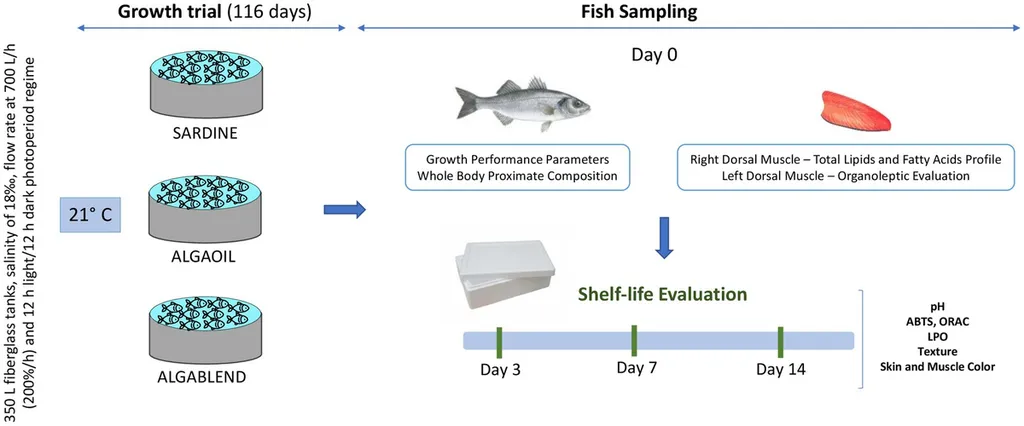In the ever-evolving world of aquaculture, researchers are constantly seeking ways to optimize fish farming practices to meet the growing global demand for seafood. A recent study published in *Frontiers in Physiology* (which translates to *Frontiers in Physiology* in English) by Guoxiong Jin and colleagues from the Key Laboratory of Mariculture at Ocean University of China, Qingdao, sheds light on how salinity and dietary lipid sources can influence the growth and health of spotted sea bass (Lateolabrax maculatus). The findings could have significant implications for the aquaculture industry, particularly in terms of energy efficiency and sustainability.
The study, titled “Interactive effects of salinity and dietary lipid sources on growth, hepatic lipid metabolism, and transcriptomic profiles in spotted sea bass (Lateolabrax maculatus),” investigated how different salinities and lipid sources affect the fish’s growth performance, hepatic lipid metabolism, and underlying molecular mechanisms. The researchers reared fish at two different salinities—0‰ (freshwater) and 20‰ (seawater)—and fed them diets containing either fish oil (FO) or soybean oil (SO) for 126 days.
The results were intriguing. Rearing fish at 20‰ salinity significantly enhanced growth performance but also increased hepatic lipid accumulation compared to rearing at 0‰ salinity. Interestingly, under the same salinity conditions, dietary lipid sources had no significant effect on fish growth performance. However, the SO-based diet significantly increased hepatic lipid accumulation compared to the FO-based diet.
One of the most compelling findings was the interactive effect of salinity and dietary lipid sources. “Salinity significantly enhanced the growth-promoting effect of the SO-based diet, but it also aggravated hepatic lipid accumulation in fish,” explained Guoxiong Jin, the lead author of the study. This suggests that while SO can be a viable alternative to FO for enhancing growth, its use in seawater environments may need to be carefully managed to prevent excessive lipid accumulation.
The study also delved into the molecular mechanisms behind these observations. Using RNA sequencing, the researchers identified 9,854 common differentially expressed genes (DEGs). They found that salinity primarily altered processes related to membrane integrity and energy metabolism, while lipid sources regulated organelle structure and fatty acid synthesis. The interaction between salinity and lipid sources influenced catalytic activity and membrane integration processes.
KEGG pathway analysis revealed that salinity-driven shifts in energy/carbohydrate metabolism and lipid-energy sensing, whereas lipid sources dominated fatty acid synthesis. Gene Set Enrichment Analysis (GSEA) further highlighted lipid source-dependent regulation of glycerolipid metabolism and unsaturated fatty acid synthesis, alongside salinity-responsive pathways including Ppar signaling and steroid biosynthesis.
The study identified several key lipid-related genes (pltp, dgat1, cyp24a1, acadsb) that exhibited differential expression patterns modulated by salinity-lipid interactions. These findings could pave the way for the development of precise nutritional strategies for raising spotted sea bass in varying salinity environments.
So, what does this mean for the aquaculture industry? The study suggests that replacing FO with SO across salinities is viable when combined with functional additives to regulate lipid metabolism. However, SO inclusion rates should be adjusted downward in seawater to minimize lipid accumulation and optimize performance.
As Guoxiong Jin noted, “Our findings support the development of precise nutritional strategies for raising spotted sea bass in varying salinity environments. This could have significant implications for the energy sector, as optimizing fish growth and health can lead to more efficient and sustainable aquaculture practices.”
In the broader context, this research highlights the importance of understanding the interactive effects of environmental factors and dietary components on fish physiology. As the aquaculture industry continues to grow, such insights will be crucial for developing sustainable and energy-efficient farming practices. The study published in *Frontiers in Physiology* serves as a testament to the ongoing efforts to optimize aquaculture practices and meet the global demand for seafood in a sustainable manner.

